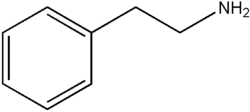Substituted phenethylamine
Overview of substituted phenethylamines
Substituted Phenethylamines[edit]
Substituted phenethylamines are a class of compounds that are structurally related to the phenethylamine molecule. These compounds are characterized by the presence of a phenethylamine core, which consists of a phenyl ring attached to an ethylamine chain. The substitution of various functional groups on the phenyl ring or the ethylamine chain results in a wide variety of compounds with diverse pharmacological properties.
Chemical Structure[edit]
The basic structure of a phenethylamine consists of a benzene ring (phenyl group) attached to a two-carbon chain ending in an amine group (ethylamine). Substitutions can occur at various positions on the benzene ring or on the ethylamine chain, leading to different chemical and pharmacological properties.

Pharmacology[edit]
Substituted phenethylamines can act as neurotransmitters, neuromodulators, or psychoactive drugs. They often interact with monoamine receptors, such as dopamine, serotonin, and norepinephrine receptors, influencing mood, perception, and cognition.
Psychoactive Effects[edit]
Many substituted phenethylamines are known for their psychoactive effects. For example, amphetamine and its derivatives are potent central nervous system stimulants, while others like MDMA (3,4-methylenedioxy-N-methylamphetamine) are known for their empathogenic and entactogenic effects.
Therapeutic Uses[edit]
Some substituted phenethylamines have therapeutic applications. For instance, amphetamines are used in the treatment of attention deficit hyperactivity disorder (ADHD) and narcolepsy.
Examples of Substituted Phenethylamines[edit]
Amphetamines[edit]
Amphetamines are a well-known class of substituted phenethylamines. They include:
Phenethylamine Hallucinogens[edit]
Some substituted phenethylamines are known for their hallucinogenic properties, such as:
Other Derivatives[edit]
Other notable derivatives include:
- Bupropion - an atypical antidepressant
- Phenylephrine - a decongestant
Synthesis[edit]
The synthesis of substituted phenethylamines involves the introduction of various functional groups onto the phenethylamine core. This can be achieved through different chemical reactions, such as alkylation, acylation, or halogenation.
Safety and Legal Status[edit]
The safety and legal status of substituted phenethylamines vary widely depending on the specific compound. Some are controlled substances due to their potential for abuse and addiction, while others are legally available for medical use.
Related Pages[edit]
Ad. Transform your life with W8MD's Budget GLP-1 injections from $75


W8MD offers a medical weight loss program to lose weight in Philadelphia. Our physician-supervised medical weight loss provides:
- Weight loss injections in NYC (generic and brand names):
- Zepbound / Mounjaro, Wegovy / Ozempic, Saxenda
- Most insurances accepted or discounted self-pay rates. We will obtain insurance prior authorizations if needed.
- Generic GLP1 weight loss injections from $75 for the starting dose.
- Also offer prescription weight loss medications including Phentermine, Qsymia, Diethylpropion, Contrave etc.
NYC weight loss doctor appointmentsNYC weight loss doctor appointments
Start your NYC weight loss journey today at our NYC medical weight loss and Philadelphia medical weight loss clinics.
- Call 718-946-5500 to lose weight in NYC or for medical weight loss in Philadelphia 215-676-2334.
- Tags:NYC medical weight loss, Philadelphia lose weight Zepbound NYC, Budget GLP1 weight loss injections, Wegovy Philadelphia, Wegovy NYC, Philadelphia medical weight loss, Brookly weight loss and Wegovy NYC
|
WikiMD's Wellness Encyclopedia |
| Let Food Be Thy Medicine Medicine Thy Food - Hippocrates |
Medical Disclaimer: WikiMD is not a substitute for professional medical advice. The information on WikiMD is provided as an information resource only, may be incorrect, outdated or misleading, and is not to be used or relied on for any diagnostic or treatment purposes. Please consult your health care provider before making any healthcare decisions or for guidance about a specific medical condition. WikiMD expressly disclaims responsibility, and shall have no liability, for any damages, loss, injury, or liability whatsoever suffered as a result of your reliance on the information contained in this site. By visiting this site you agree to the foregoing terms and conditions, which may from time to time be changed or supplemented by WikiMD. If you do not agree to the foregoing terms and conditions, you should not enter or use this site. See full disclaimer.
Credits:Most images are courtesy of Wikimedia commons, and templates, categories Wikipedia, licensed under CC BY SA or similar.
Translate this page: - East Asian
中文,
日本,
한국어,
South Asian
हिन्दी,
தமிழ்,
తెలుగు,
Urdu,
ಕನ್ನಡ,
Southeast Asian
Indonesian,
Vietnamese,
Thai,
မြန်မာဘာသာ,
বাংলা
European
español,
Deutsch,
français,
Greek,
português do Brasil,
polski,
română,
русский,
Nederlands,
norsk,
svenska,
suomi,
Italian
Middle Eastern & African
عربى,
Turkish,
Persian,
Hebrew,
Afrikaans,
isiZulu,
Kiswahili,
Other
Bulgarian,
Hungarian,
Czech,
Swedish,
മലയാളം,
मराठी,
ਪੰਜਾਬੀ,
ગુજરાતી,
Portuguese,
Ukrainian